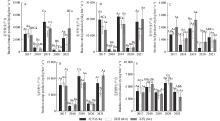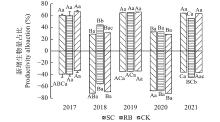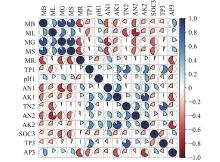

Scientia Silvae Sinicae ›› 2023, Vol. 59 ›› Issue (2): 22-29.doi: 10.11707/j.1001-7488.LYKX20220346
• • Previous Articles Next Articles
Yaxiong Zheng1,2,Shaohui Fan1,Xuan Zhang1,2,Xiao Zhou1,2,Fengying Guan1,2,*
Received:2022-05-14
Online:2023-02-25
Published:2023-04-27
Contact:
Fengying Guan
CLC Number:
Yaxiong Zheng,Shaohui Fan,Xuan Zhang,Xiao Zhou,Fengying Guan. Productivity Dynamics of Moso Bamboo (Phyllostachys edulis) Forest after Strip Clearcutting[J]. Scientia Silvae Sinicae, 2023, 59(2): 22-29.
Table 1
Basic information of sample plots"
| 样地 Plot | 坡度 Slope/(°) | 海拔 Altitude/m | 密度 Density/(individual·hm?2) | 竹龄结构 Age structureⅠ∶Ⅱ∶Ⅲ | 平均胸径 Mean DBH/cm | 平均枝下高 Mean height to crown base/m | 平均竹高 Mean tree height/m |
| SC1 | 5 | 113 | 3 250 | 18∶17∶17 | 8.68 | 4.10 | 12.91 |
| SC2 | 6 | 113 | 3 861 | 17∶23∶22 | 9.13 | 4.60 | 13.75 |
| SC3 | 6 | 113 | 3 187 | 16∶18∶17 | 8.49 | 5.09 | 13.21 |
| RB1 | 6 | 113 | 3 452 | 19∶20∶16 | 8.83 | 4.76 | 12.85 |
| RB2 | 6 | 114 | 3 815 | 21∶18∶22 | 8.88 | 4.06 | 13.22 |
| RB3 | 5 | 114 | 3 687 | 19∶21∶19 | 9.38 | 5.07 | 13.53 |
| CK1 | 6 | 113 | 3 657 | 17∶22∶20 | 9.06 | 4.23 | 13.33 |
| CK2 | 6 | 113 | 3 756 | 20∶22∶18 | 8.77 | 4.43 | 13.63 |
| CK3 | 5 | 114 | 3 948 | 21∶23∶19 | 8.90 | 4.40 | 13.21 |

Fig.1
Dynamics of each component productivity of moso bamboo in different treatment plots Different lowercase letters indicate a significant difference in (A branch、B stem、C leaf、D stump、E root) productivity between the different treatment plots at the same times (P<0.05); Different capital letters indicate a significant difference in (A branch、B stem、C leaf、D stump、E root) productivity between the different times in the same treatment plot (P<0.05)."


Fig.2
Dynamics of productivity allocation of new bamboo trees under different treatments Different lowercase letters indicate a significant difference in productivity allocation between the different treatment plots at the same time (P<0.05); Different capital letters indicate a significant difference in productivity allocation between the different times in the same treatment plot(P<0.05). The column at the top of the abscissa represents the productivity allocation of new bamboo trees in the aboveground part; The column at the bottom of the abscissa represents the productivity allocation of new bamboo trees in the underground part."


Fig.4
Correlation ship between component productivity and soil nutrients in strip clear-cutting plots MB: bamboo branch productivity; ML: leaf productivity of moso bamboo; MC: moso bamboo stem productivity; MS: moso bamboo stump productivity; MR: root productivity; 1 represents 0–10 cm soil layer, 2 represents 10–20 cm soil layer, and 3 represents 20–40 cm soil layer. For example, SOC1 represents the soil organic carbon content in the 0–10 cm soil layer."

|
范少辉, 刘广路, 苏文会, 等 竹林培育研究进展. 林业科学研究, 2018, 31 (1): 137- 144.
doi: 10.13275/j.cnki.lykxyj.2018.01.017 |
|
|
Fan S H, Liu G L, Su W H, et al Advances in research of bamboo forest cultivation. Forest Research, 2018, 31 (1): 137- 144.
doi: 10.13275/j.cnki.lykxyj.2018.01.017 |
|
|
范少辉, 刘广路, 苏文会, 等 闽西北不同类型毛竹林生物量分布格局. 安徽农业大学学报, 2011, 38 (6): 842- 847.
doi: 10.13610/j.cnki.1672-352x.2011.06.028 |
|
|
Fan S H, Liu G L, Su W H, et al The biomasss distribution of different Phyllostachys edulis forest types in Northwest of Fujian Province . Journal of Anhui Agricultural University, 2011, 38 (6): 842- 847.
doi: 10.13610/j.cnki.1672-352x.2011.06.028 |
|
| 郭宝华, 刘广路, 范少辉, 等 不同生产力水平毛竹林碳氮磷的分布格局和计量特征. 林业科学, 2014, 50 (6): 1- 9. | |
| Guo B H, Liu G L, Fan S H, et al Distribution patterns and stoichiometry characteristics of C, N, P in Phyllostachys edulis forests of different productivity levels . Scientia Silvae Sinicae, 2014, 50 (6): 1- 9. | |
|
江国华, 余立华, 李占东, 等 毛竹地下竹鞭的分支系统及其数量特征. 生态学杂志, 2017, 36 (12): 3479- 3484.
doi: 10.13292/j.1000-4890.201712.018 |
|
|
Jiang G H, Yu L H, Li Z D, et al Hierarchical system and its quantitative attribute of moso bamboo rhizome. Chinese Journal of Ecology, 2017, 36 (12): 3479- 3484.
doi: 10.13292/j.1000-4890.201712.018 |
|
| 江泽慧. 2002. 世界竹藤. 沈阳: 辽宁科学技术出版社. | |
| Jiang, Z H. 2002. Bamboo and rattan in the world. Shenyang: Liaoning Science and Technology Publishing House. [in Chinese] | |
| 刘广路, 范少辉, 蔡春菊, 等 毛竹向撂荒地扩展过程中叶功能性状变化. 南京林业大学学报(自然科学版), 2017, 41 (2): 41- 46. | |
| Liu G L, Fan S H, Cai C J, et al Leaf functional traits of moso bamboo during its expansion into abandoned land. Journal of Nanjing Forestry University ( Natural Sciences Edition), 2017, 41 (2): 41- 46. | |
|
陆媛媛, 周紫球, 李 川, 等 毛竹冬笋生长特点研究. 浙江林业科技, 2011, 31 (1): 59- 63.
doi: 10.3969/j.issn.1001-3776.2011.01.012 |
|
|
Lu Y Y, Zhou Z Q, Li C, et al Analysis on growth characteristics of winter shoot of Phyllostachys heterocycla cv. pubescens . Journal of Zhejiang Forestry Science and Technology, 2011, 31 (1): 59- 63.
doi: 10.3969/j.issn.1001-3776.2011.01.012 |
|
| 宋艳冬, 金爱武, 金晓春, 等 施肥对毛竹叶片光合生理的影响. 浙江林学院学报, 2010, 27 (3): 334- 339. | |
| Song Y D, Jin A W, Jin X C, et al Physiology of leaf photosynthesis with fertilization in Phyllostachys pubescens . Journal of Zhejiang Forestry College, 2010, 27 (3): 334- 339. | |
| 苏文会. 2012. 基于生长和养分积累规律的毛竹林施肥理论与实践研究. 北京: 中国林业科学研究院. | |
| Su W H. 2012. Fertilization theory and practice for Phyllostachys edulis stand based on growth and nutrient accumulation rules. Beijing: Chinese Academy of Forestry. [in Chinese] | |
| 王树梅. 2021. 带状采伐毛竹林地下鞭根系统与地面成竹响应特征的研究. 北京: 中国林业科学研究院. | |
| Wang S M. 2021. Study on response characteristics of underground whip root system and ground growth of Phyllostachys edulis forests under different strip cutting. Beijing: Chinese Academy of Forestry. [in Chinese] | |
| 王树梅, 范少辉, 肖 箫, 等 带状采伐对毛竹地上生物量分配及异速生长的影响. 南京林业大学学报(自然科学版), 2021, 45 (5): 19- 24. | |
| Wang S M, Fan S H, Xiao X, et al Effects of strip cutting on aboveground biomass accumulation and allocation, and allometric growth of Phyllostachys edulis . Journal of Nanjing Forestry University ( Natural Sciences Edition), 2021, 45 (5): 19- 24. | |
| 吴昌明. 2020. 闽中毛竹林带状采伐后土壤微生物群落结构的早期响应. 北京: 中国林业科学研究院. | |
| Wu C M. 2020. Early response of soil microbial community structure after strip cutting in moso bamboo forest in central Fujian. Beijing: Chinese Academy of Forestry. [in Chinese] | |
|
吴家森, 周国模, 徐秋芳, 等 不同年份毛竹营养元素的空间分布及与土壤养分的关系. 林业科学, 2005, 41 (3): 171- 173.
doi: 10.3321/j.issn:1001-7488.2005.03.028 |
|
|
Wu J S, Zhou G M, Xu Q F, et al Spatial Distribution of Nutrition Element and Its Relationship with Soil Nutrients in Different Years of Phyllostachys pubescens . Scientia Silvae Sinicae, 2005, 41 (3): 171- 173.
doi: 10.3321/j.issn:1001-7488.2005.03.028 |
|
| 曾宪礼. 2019. 皖南毛竹林带状采伐恢复特征及影响因子研究. 北京: 中国林业科学研究院. | |
| Zeng X L. 2019. Recovery characteristics and influencing factors of Moso bamboo forests under different strip clearcutting in south Anhui Province. Beijing: Chinese Academy of Forestry. [in Chinese] | |
|
曾宪礼, 苏文会, 范少辉, 等 带状采伐毛竹林恢复的质量特征研究. 西北植物学报, 2019, 39 (5): 917- 924.
doi: 10.7606/j.issn.1000-4025.2019.05.0917 |
|
|
Zeng X L, Su W H, Fan S H, et al Qualitative recovery characteristics of moso bamboo forests under strip clearcutting. Acta Botanica Boreali-Occidentalia Sinica, 2019, 39 (5): 917- 924.
doi: 10.7606/j.issn.1000-4025.2019.05.0917 |
|
| 詹美春. 2019. 苏南带状采伐毛竹林林分恢复特征研究. 北京: 中国林业科学研究院. | |
| Zhan M C. 2019. Characteristic research on rapid regeneration of strip harvesting bamboo (Phyllostachys edulis) forest in Jiangsu Province. Beijing: Chinese Academy of Forestry. [in Chinese] | |
| 詹美春, 官凤英, 晏颖杰, 等 带状采伐对毛竹林林下植被物种多样性的影响. 生态学报, 2020, 40 (12): 4169- 4179. | |
| Zhan M C, Guan F Y, Yan Y J, et al Effects of strip harvesting on species diversity of undergrowth in bamboo (Phyllostachys Edulis) forest . Chinese Journal of Ecology, 2020, 40 (12): 4169- 4179. | |
| 张幼法, 林世奎, 张世渊 毛竹林地下鞭动态生长的研究. 竹子研究汇刊, 1999, 18 (3): 62- 65. | |
| Zhang Y F, Lin S K, Zhang S Y A study on dynamic growth of underground rhizome of Phyllostachys pubescens . Journal of Bamboo Research, 1999, 18 (3): 62- 65. | |
| 郑郁善, 洪 伟, 陈礼光, 等 毛竹丰产林竹鞭结构特征研究. 林业科学, 1998, 34 (S1): 52- 59. | |
| Zheng Y S, Hong W, Chen L G, et al Study on structure characteristics of rhizomes in high yield Phyllostachys heterocycla cv. pubescens forests . Scientia Silvae Sinicae, 1998, 34 (S1): 52- 59. | |
| 朱强根, 金爱武, 王意锟, 等 不同营林模式下毛竹枝叶的生物量分配: 异速生长分析. 植物生态学报, 2013, 37 (9): 811- 819. | |
| Zhu G Q, Jin A W, Wang Y K, et al Biomass allocation of branches and leaves in Phyllostachys heterocycla ‘Pubescens’ under different management modes: allometric scaling analysis . Chinese Journal of Plant Ecology, 2013, 37 (9): 811- 819. | |
| 庄明浩, 李迎春, 陈双林 竹子生理整合作用的生态学意义及研究进展. 竹子研究汇刊, 2011, 30 (2): 5- 9. | |
| Zhuang M H, Li Y C, Chen S L Advances in the researches of bamboo physiological integration and its ecological significance. Journal of Bamboo Research, 2011, 30 (2): 5- 9. | |
|
庄若楠, 金爱武 施肥对毛竹秆型特征的影响. 中南林业科技大学学报, 2013, 33 (1): 80- 84.
doi: 10.14067/j.cnki.1673-923x.2013.01.017 |
|
|
Zhuang R N, Jin A W Effects of fertilization on culm form characteristics of Phyllostachys pubescens . Journal of Central South University of Forestry & Technology, 2013, 33 (1): 80- 84.
doi: 10.14067/j.cnki.1673-923x.2013.01.017 |
|
|
Li L W, Li N, Lu D S, et al Mapping moso bamboo forest and its on-year and off-year distribution in a subtropical region using time-series Sentinel-2 and Landsat 8 data. Remote Sensing of Environment, 2019, 231, 111265.
doi: 10.1016/j.rse.2019.111265 |
|
| Mao F J, Zhou G M, Li P H, et al Optimizing selective cutting strategies for maximum carbon stocks and yield of moso bamboo forest using BIOME-BGC model. Forest Ecology and Management, 2017, 191, 126- 135. | |
|
Su W H, Fan S H, Zhao J C, et al Effects of various fertilization placements on the fate of urea-15N in moso bamboo forests . Forest Ecology and Management, 2019, 453, 117632.
doi: 10.1016/j.foreco.2019.117632 |
|
|
Vangansbeke P, De Schrijver A, De Frenne P, et al Strong negative impacts of whole tree harvesting in pine stands on poor, sandy soils: a long-term nutrient budget modelling approach. Forest Ecology and Management, 2015, 356, 101- 111.
doi: 10.1016/j.foreco.2015.07.028 |
|
|
Zheng Y X, Fan S H, Zhou X, et al Dynamics of stand productivity in moso bamboo forest after strip cutting. Frontiers in Plant Science, 2022a, 13, 1064232.
doi: 10.3389/fpls.2022.1064232 |
|
|
Zheng Y X, Fan S H, Guan F Y, et al Strip clearcutting drives vegetation diversity and composition in the moso bamboo forests. Forest Science, 2022b, 68 (1): 27- 36.
doi: 10.1093/forsci/fxab044 |
|
|
Zheng Y X, Guan F Y, Fan S H, et al Dynamics of leaf-litter biomass, nutrient resorption efficiency and decomposition in a moso bamboo forest after strip clearcutting. Frontiers in Plant Science, 2022c, 12, 799424.
doi: 10.3389/fpls.2021.799424 |
|
|
Zheng Y X, Guan F Y, Fan S H, et al Functional trait responses to strip clearcutting in a moso bamboo forest. Forests, 2021, 12 (6): 793.
doi: 10.3390/f12060793 |
| Viewed | ||||||
|
Full text |
|
|||||
|
Abstract |
|
|||||